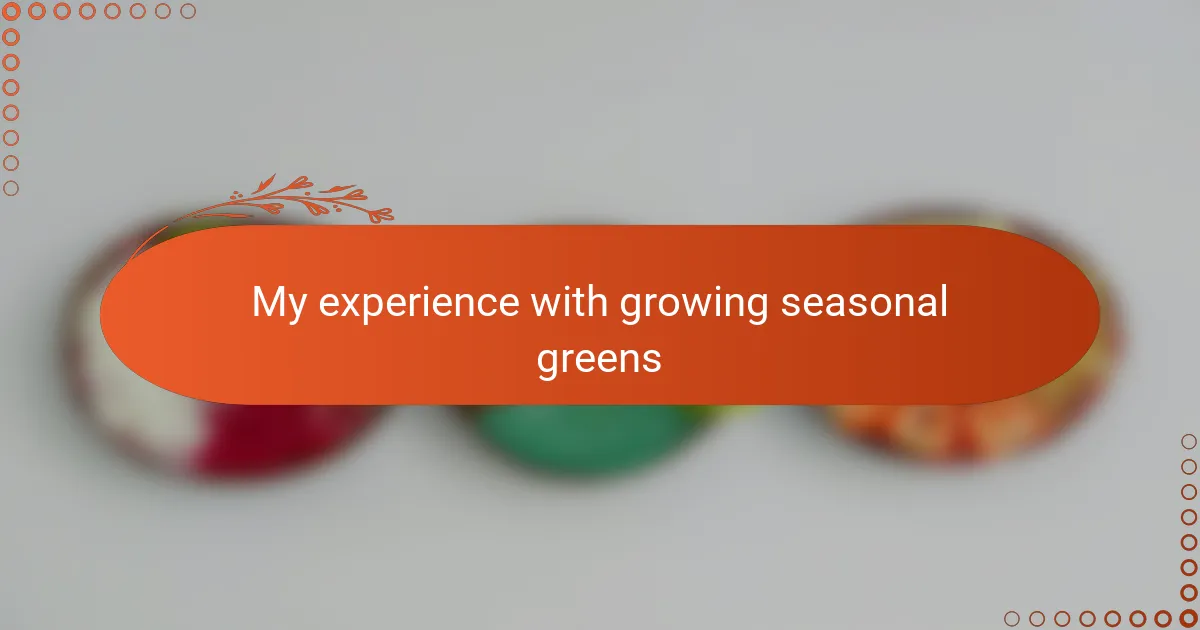Key takeaways
- Understanding seasonal greens enhances garden yield and culinary creativity, emphasizing the importance of timing and plant compatibility with weather conditions.
- Proper soil preparation, including enriching with organic matter and testing pH, is crucial for healthy growth and flavorful greens.
- Selective harvesting techniques, such as picking leaves in the morning and snipping outer leaves, improve plant health and yield.
- Cooking with homegrown greens allows for nutritional creativity, turning simple ingredients into delicious dishes that celebrate the season.
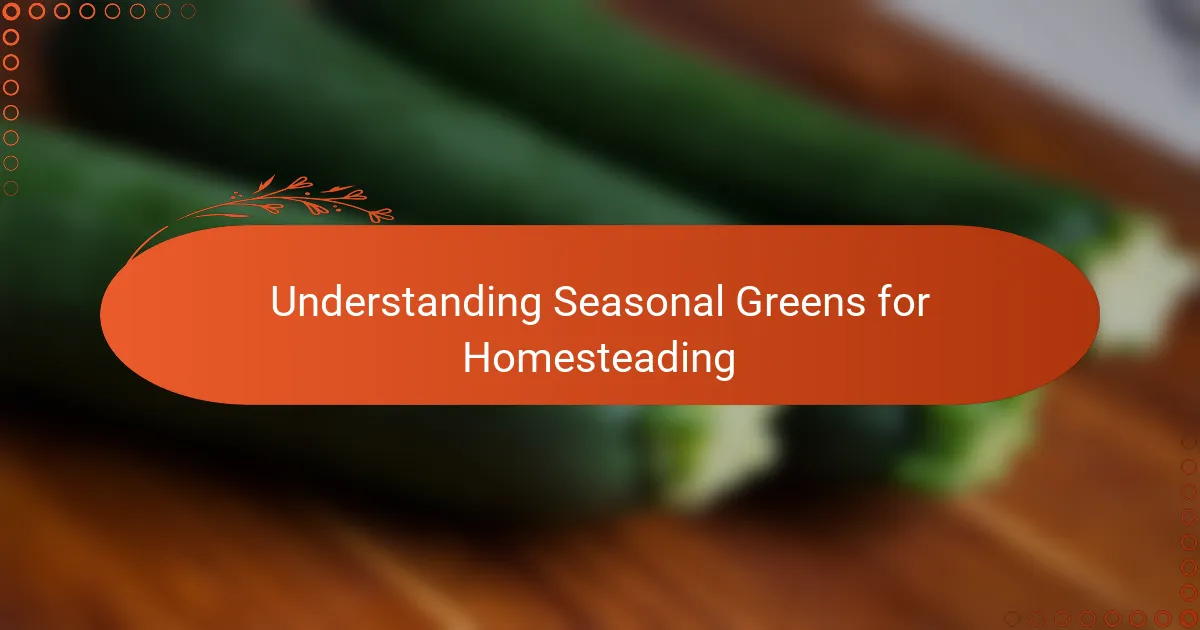
Understanding Seasonal Greens for Homesteading
Understanding seasonal greens is essential for any homesteader aiming to make the most of their garden’s yield. I’ve found that knowing when specific greens thrive not only improves my harvest but also deepens my connection to the natural rhythms around me. Have you ever noticed how your kitchen feels different when you’re cooking with fresh, in-season leaves?
From my experience, seasonal greens like spinach in early spring or kale in the colder months bring distinct flavors and textures that off-season produce can’t match. It’s a subtle reminder that nature’s timing matters—a lesson I’ve learned firsthand after a few failed attempts at growing summer greens in the fall. These cycles teach patience and respect, qualities that every homesteader cultivates alongside their crops.
What’s exciting about seasonal greens is how they encourage creativity in the kitchen. I often find myself experimenting with recipes that highlight their peak flavors, which transforms simple meals into nourishing celebrations of the season. Isn’t that the real joy of homesteading—tuning in to nature’s schedule and letting it inspire how and what we eat?
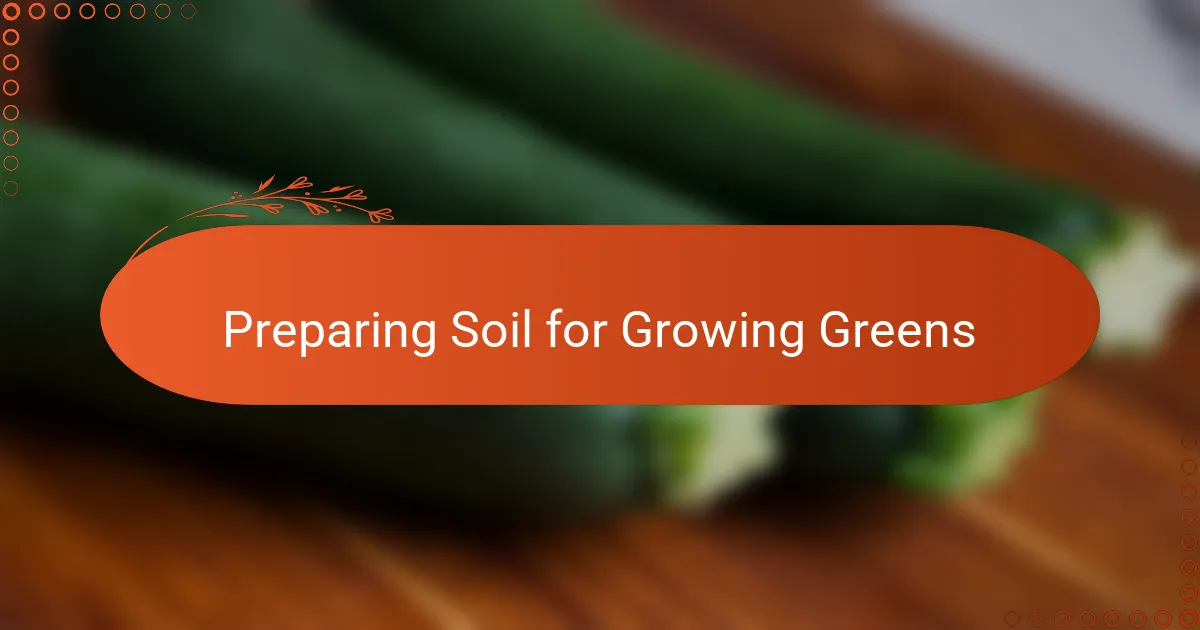
Preparing Soil for Growing Greens
When it comes to preparing soil for growing greens, I learned that it’s more than just digging a patch and planting seeds. I’ve seen how enriching the soil with organic matter, like compost or well-rotted manure, makes a world of difference—greens seem to flourish when their roots can easily access nutrients and moisture. Have you ever noticed how plants grown in healthy soil just look happier and stronger?
One season, I skipped this step and planted directly into tired soil, hoping for the best. The results were disappointing; my greens grew slowly and tasted bland. That experience taught me the importance of loosening the soil to improve aeration and drainage—after all, greens like their roots to breathe.
Before planting, I always take a moment to test the soil’s pH because some greens prefer slightly acidic to neutral conditions. Adjusting with natural materials like garden lime or sulfur has helped me avoid common problems like yellowing leaves or stunted growth. Have you tried this simple check? It might seem small, but it can save you from frustration later on.
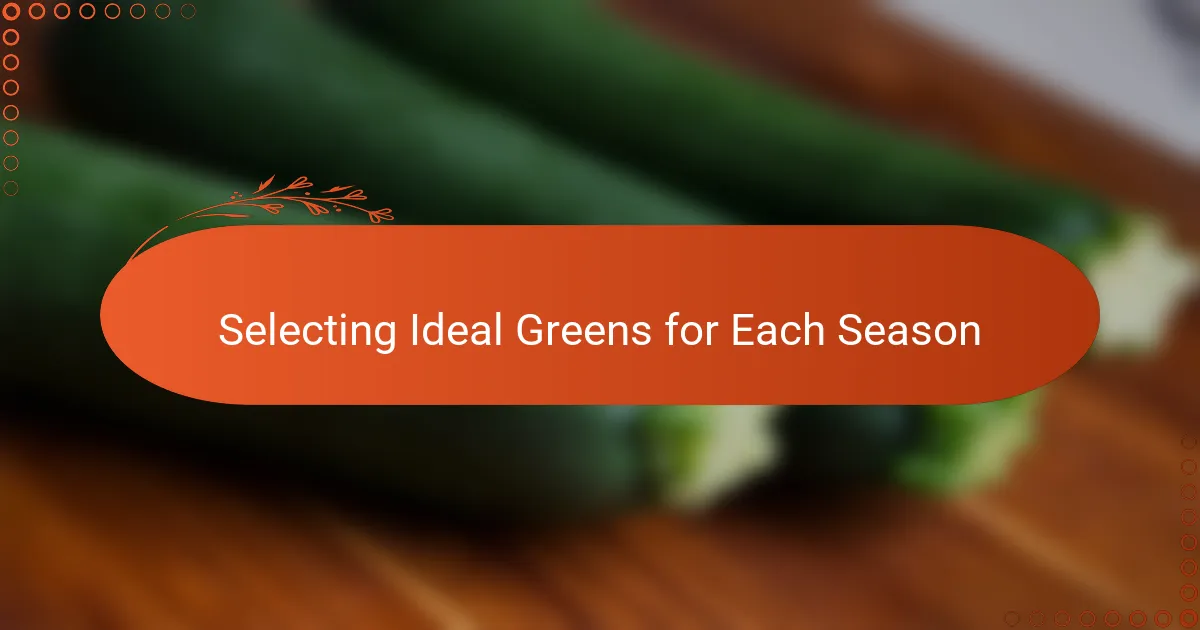
Selecting Ideal Greens for Each Season
Choosing the right greens for each season has been a game-changer in my homesteading journey. I remember one spring when I planted chard too late, only to watch it struggle in the heat—since then, I’ve learned to prioritize cool-weather favorites like spinach and arugula early on. Have you noticed how some greens just seem to love the chill while others thrive under warmer sun?
Winter greens like kale and collards have a special place in my garden because they seem almost indestructible in cold weather. I’ve found that picking varieties known for cold tolerance keeps my harvest steady even when frost appears overnight. Isn’t it comforting to know your garden can still provide fresh, vibrant greens when most things outside look dormant?
Summer presents its own challenge, but I’ve discovered that planting heat-tolerant greens such as Malabar spinach or New Zealand spinach keeps my kitchen stocked through the hottest months. It made me realize how matching greens to seasonal conditions isn’t just about timing—it’s about giving each plant the best shot to thrive and flavor my meals. What seasonal greens have you tried that surprised you with their resilience?
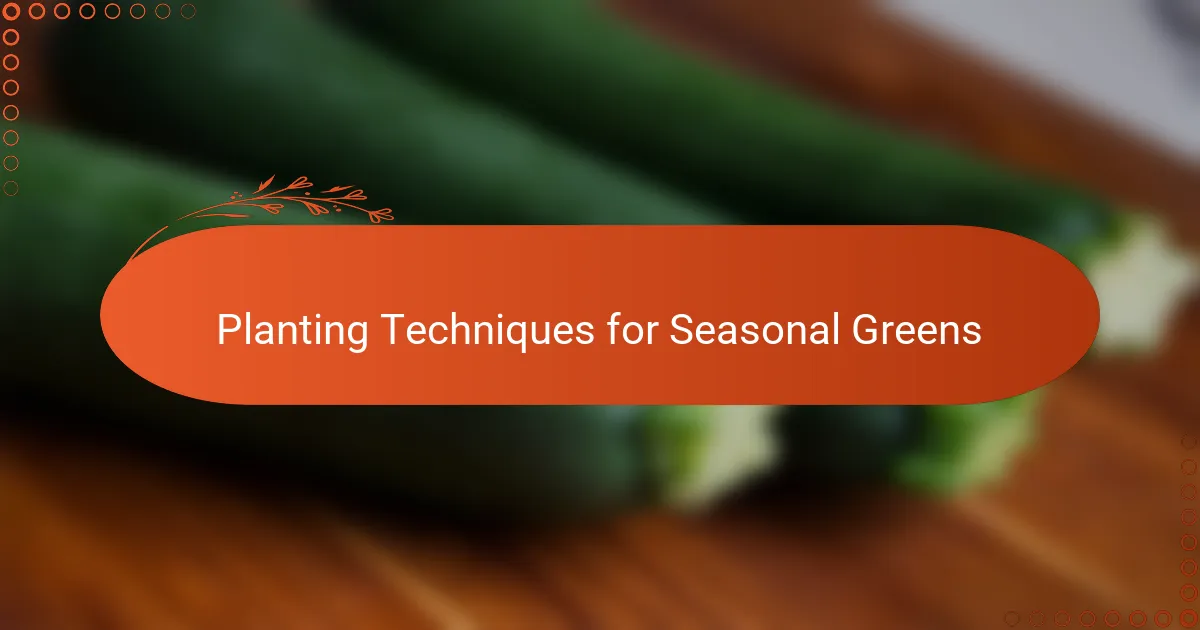
Planting Techniques for Seasonal Greens
I’ve found that direct sowing seasonal greens like spinach and arugula works best for me, especially when the soil is warm enough to encourage quick germination. Have you ever waited impatiently for tiny seedlings to peek through the soil? That first sign of life always feels like a small victory in my garden.
Timing is everything with planting. For example, I learned the hard way that waiting too long to transplant broccoli greens in spring meant dealing with leggy, stressed plants. Now, I carefully monitor the weather and start some seeds indoors to give them a head start, which has made a noticeable difference in their vigor.
Spacing has surprised me too. When I crammed my kale seedlings too close, the leaves were smaller and more prone to disease. Giving each plant enough room to breathe changed the game—larger leaves, healthier plants, and a harvest that made my effort feel truly rewarding. Have you tried adjusting your plant spacing to see its impact?
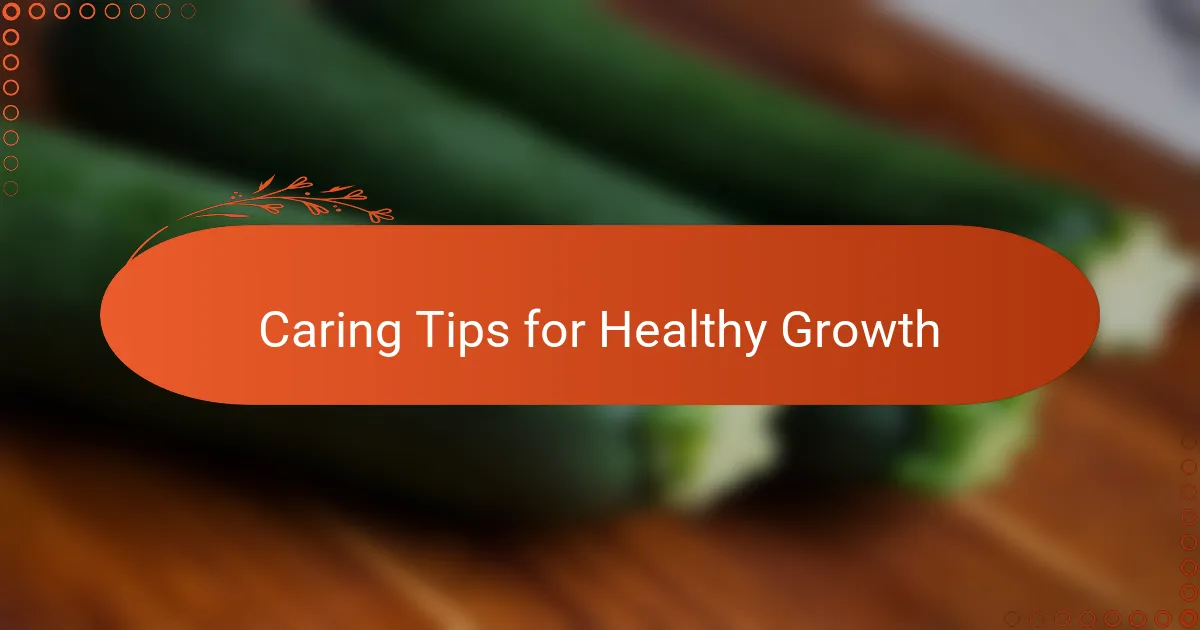
Caring Tips for Healthy Growth
Caring for seasonal greens means paying close attention to their water needs. From my experience, keeping the soil consistently moist—but never soggy—makes a huge difference in how tender and flavorful the leaves turn out. Have you noticed how stressed plants often develop bitter or tough leaves? Avoiding that dryness is key.
I’ve also learned that regular feeding with a balanced, organic fertilizer gives my greens a vital boost during their active growth phase. It’s like giving them a little energy drink, helping them build lush, vibrant foliage. What surprised me is how much faster my greens recover from minor pests or weather swings when they’re well nourished.
One simple habit that’s improved my greens’ health tremendously is routine checking for pests and diseases. Catching problems early on, before they spread, saves so much heartache and wasted harvest. Sometimes, I feel like a detective in my own garden—have you ever spotted a tiny bug and wondered if it’s friend or foe? Knowing when to intervene and when to let nature take its course is a delicate balance I’m always striving to perfect.
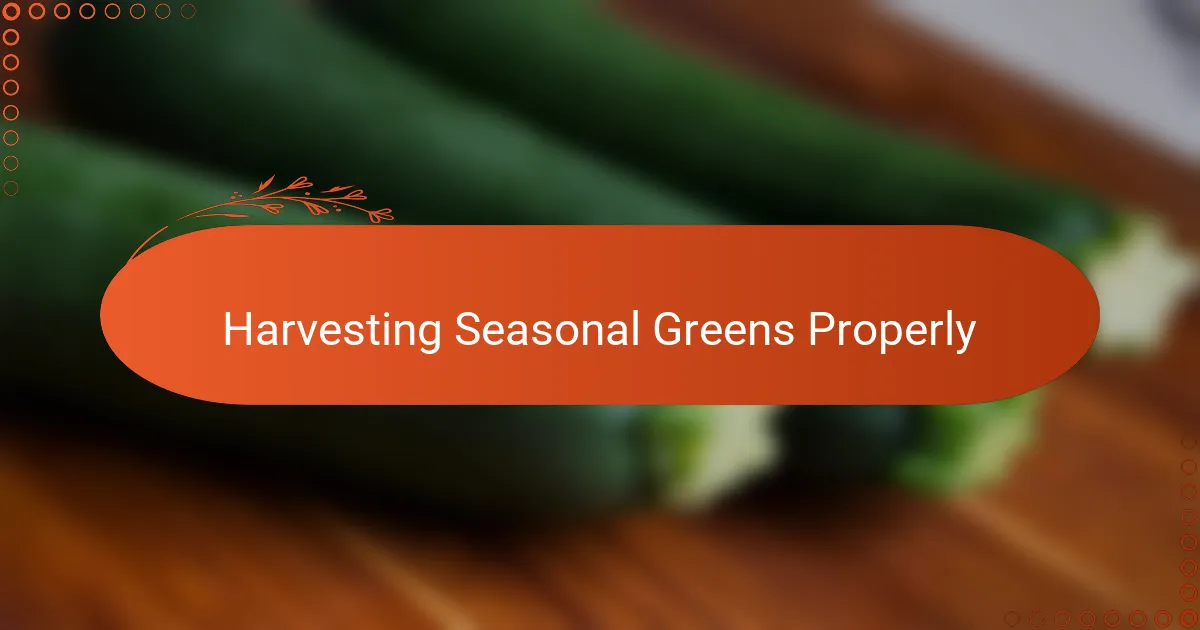
Harvesting Seasonal Greens Properly
Harvesting seasonal greens properly has been a crucial step in my homesteading routine. I’ve learned that picking leaves early in the morning, when they’re crisp and full of moisture, really preserves their flavor and texture. Have you ever noticed how greens picked midday sometimes feel a bit wilted before you even start cooking?
One season, I got a little overenthusiastic and harvested too many leaves at once. The rest of the plant slowed down, and I ended up with smaller yields later on. That taught me the importance of selective picking—snipping only the outer leaves and leaving the inner ones to keep growing strong. It’s like giving your plants room to breathe and recover, which pays off with better harvests over time.
Another thing I always remind myself is to use clean, sharp scissors or garden shears. I used to tear leaves by hand, which bruised the plants and invited pests or disease. Since switching tools, my greens look healthier and store longer. Isn’t it satisfying when a simple change like that makes your harvest even sweeter?
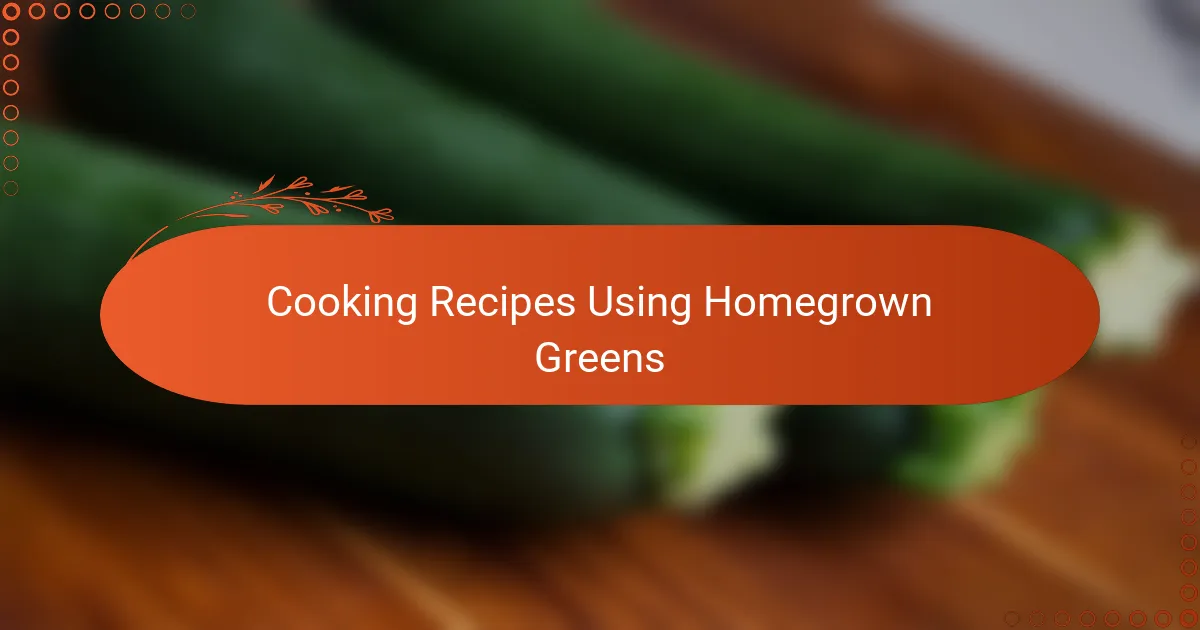
Cooking Recipes Using Homegrown Greens
Cooking with homegrown greens has always felt like a special kind of satisfaction to me. There’s something about turning those fresh, crisp leaves from my garden into a vibrant salad or a warm, garlicky sauté that just tastes better than anything store-bought. Have you ever noticed how the flavors of homegrown spinach or kale can brighten even the simplest dishes?
I often find that quick recipes work best to showcase the delicate textures of seasonal greens. For example, tossing baby arugula with lemon juice, olive oil, and a sprinkle of parmesan makes a refreshing side that’s both easy and delicious. One time, I added some freshly picked mustard greens to a stir-fry, and the slight peppery bite completely transformed the meal—definitely a happy accident!
Sometimes, I like to experiment by blending greens into soups or smoothies. It’s a fantastic way to pack nutrients into a meal without sacrificing taste. Have you ever tried a homemade green pesto using kale or chard? From my experience, the vibrant color and earthy flavor bring a new twist to classic dishes, reminding me why growing my own greens is worth every bit of effort.
